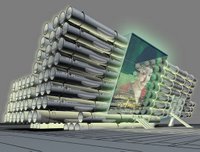It' a bird. It's a plane. It's a Library!
 Architects Lot-Ek (not sure if that is a deliberate Johnny Mnemonic reference or not) have designed a public library made from the reclaimed fuselages of 727/737 passenger jets. The fuselages are the one part on an airliner that is more expensive to recycle than it is to just junk. Hundreds of old jet bodies litter the countryside, and now someone finally found a use for them. The building is very unusual in both appearance and design. The structure sort of reminds me of capsule(coffin) hotels but on a much grander scale. I really hope this particular design sees the light of day. In addition to an amazing looking library, it will remove tons of rusting Boeing cast offs from desert graves.
Architects Lot-Ek (not sure if that is a deliberate Johnny Mnemonic reference or not) have designed a public library made from the reclaimed fuselages of 727/737 passenger jets. The fuselages are the one part on an airliner that is more expensive to recycle than it is to just junk. Hundreds of old jet bodies litter the countryside, and now someone finally found a use for them. The building is very unusual in both appearance and design. The structure sort of reminds me of capsule(coffin) hotels but on a much grander scale. I really hope this particular design sees the light of day. In addition to an amazing looking library, it will remove tons of rusting Boeing cast offs from desert graves. I think this would make a great low rent housing or hotel design as well, each fuselage could be an apartment or suite. Poking around on Google I found this military graveyard in Arizona. Enough unused fuselages there to build hotels, libraries, and apartments galore. I say we set up a few these in places like New Orleans, where people waiting for homes to be built. Then turn them into hotels once everyone is situated. And I love the LCD on the buildings facade. Something like that might just bring back the Drive In.
"The street finds its own use for things." - William Gibson



5 Comments:
Testing to see if i can even post a comment. Sorry dear readers, but Blogger.com is having some kind of a serious network wide outage. They ahve been down for atleast the last 24 hours. No posts, and no updates until it gets resolved. I apologise immensly and please bare with us.
Downsides of using obsolete aircraft fuselages:
1. Large, awkward, and surprisingly fragile structures. Transporting these, such as to the site, is complex, delicate, and thus very expensive process.
2. Cylinders aren't an efficient shape for most human-centered structures, in this case for "hallways" holding rows of shelving. The volume of space, the amount of structure required, for each liner foot of book shelf is extreme (plus the problem of retrieving materials that fall between the vertical shelves and the bowed walls.)
3. The fuselages aren't neat perfect cylinders, inside or out. They're complicated with internal ribs, fittings, external flares with wing attachments, flooring and ceiling panels, etc. They simply don't stack neatly together. Furthermore walking through these isn't shiny abstract art, it's more like a very large, messy, industrial duct.
An interesting idea, by a design team that has clearly never seen an airframe up close (or looked at photos of such) nor informed themselves about modern library design.
Basically a nice student project, not even graduate level.
Thanks for the comment Michael, and the insight. However I'd like to take a moment to address your comments.
1.Cost and difficulty of transport. I agree that there is an overhead here, but I'd wager it's far from the point of diminishing returns. We know based on the fuselages continued existence, that it is cheaper to transport them, then it is to tear them down. And keep in mind that standard bui8lding materials would also have to be transported, granted a process not as elaborate as fuselages, but a process non the less. Also, the infrastructure already exists to transport them, and carefully in the jet manufacturing industry, so the wheel would not have to be reinvented. Is there a cost, yes. Would that cost be prohibitive? I don't think we'll know without some real hard numbers. Using the material for structures to be built near airline grave yards could also alleviate cost.
2.Cylinders, curves and bows. This is a question of uniqueness of design. To solve the bookshelf problem, you could use bowed shelving. As for broader concerns, check out Buckminster Fuller's Dymaxion house a the Henry Ford Museum, or the architecture of Paolo Soleri. I give you that this is unusual and outside the box design philosophy, but that is exactly the point.
3.Taking into account the uneven external structure of the fuselages, could you not design a lattice to hold them. Assuming you had access to identical jet bodies from identical models of aircraft? i.e. Build your structure entirely from one particular Beoing 737 form factor. And as for the inside seeming more like a utility corridor than a pristine white hallway, I agree. However again this comes down to design aesthetics. Rather than dismiss the concept out of hand, ask yourself what could be done to make the utility corridor feel like the structure in the mock ups? Refitting the interior with new materials? Unique OLED light panels? Or any other industrial design/architecture tricks we can think of.
At this stage of the game, the Library is simply a design. It is unprecedented, makes use of indigenous materials, and removes hundreds of tons of refuse from the country side. Being skeptical and critical of such grandiose plans is a smart and proper response. But dismissing them out of hand is a disservice to those that dared propose such an idea, and to you. If we simply wrote of big unwieldy ideas like this in the past, we wouldn't have any jet bodies to worry about. Because we wouldn't have any jets.
Thanks again for your thought provoking response. I'm always happy to engage in some good creative discourse. And thanks for reading Memepunks!
The site in Arizona is part of Davis Montham Airforce Base and the Pima County Air Museum.
If you go North out of Tucson on I-19, towards Phoenix, you'll come across a commercial airplane graveyard. I don't have any better location info than that but I have driven by it several times.
M
Thanks for the info. Is this what you were referring to?
http://www.google.com/maps?f=q&hl=en&q=32.505726,-111.326&ll=32.506016,-111.325815&spn=0.007329,0.021629&t=h&om=1
If so I'l add it to the post as a link.
And thanks for reading Memepunks!
Post a Comment
<< Home